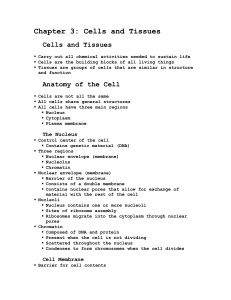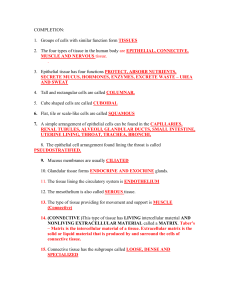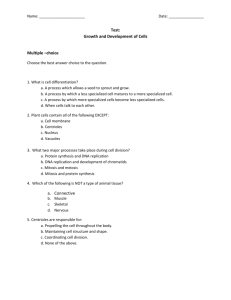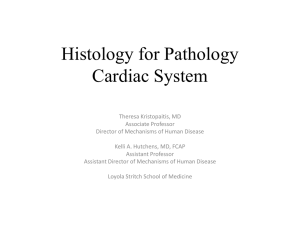Week 02_Lecture Notes_Cells & Body Tissues - TAFE-Cert
advertisement
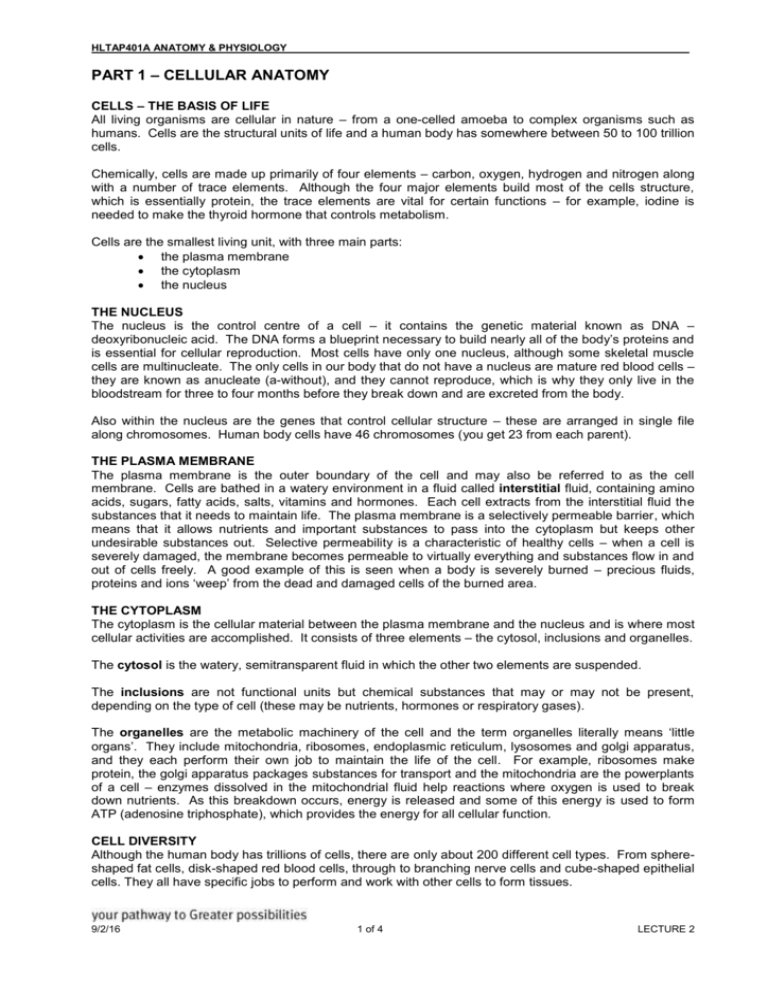
HLTAP401A ANATOMY & PHYSIOLOGY PART 1 – CELLULAR ANATOMY CELLS – THE BASIS OF LIFE All living organisms are cellular in nature – from a one-celled amoeba to complex organisms such as humans. Cells are the structural units of life and a human body has somewhere between 50 to 100 trillion cells. Chemically, cells are made up primarily of four elements – carbon, oxygen, hydrogen and nitrogen along with a number of trace elements. Although the four major elements build most of the cells structure, which is essentially protein, the trace elements are vital for certain functions – for example, iodine is needed to make the thyroid hormone that controls metabolism. Cells are the smallest living unit, with three main parts: the plasma membrane the cytoplasm the nucleus THE NUCLEUS The nucleus is the control centre of a cell – it contains the genetic material known as DNA – deoxyribonucleic acid. The DNA forms a blueprint necessary to build nearly all of the body’s proteins and is essential for cellular reproduction. Most cells have only one nucleus, although some skeletal muscle cells are multinucleate. The only cells in our body that do not have a nucleus are mature red blood cells – they are known as anucleate (a-without), and they cannot reproduce, which is why they only live in the bloodstream for three to four months before they break down and are excreted from the body. Also within the nucleus are the genes that control cellular structure – these are arranged in single file along chromosomes. Human body cells have 46 chromosomes (you get 23 from each parent). THE PLASMA MEMBRANE The plasma membrane is the outer boundary of the cell and may also be referred to as the cell membrane. Cells are bathed in a watery environment in a fluid called interstitial fluid, containing amino acids, sugars, fatty acids, salts, vitamins and hormones. Each cell extracts from the interstitial fluid the substances that it needs to maintain life. The plasma membrane is a selectively permeable barrier, which means that it allows nutrients and important substances to pass into the cytoplasm but keeps other undesirable substances out. Selective permeability is a characteristic of healthy cells – when a cell is severely damaged, the membrane becomes permeable to virtually everything and substances flow in and out of cells freely. A good example of this is seen when a body is severely burned – precious fluids, proteins and ions ‘weep’ from the dead and damaged cells of the burned area. THE CYTOPLASM The cytoplasm is the cellular material between the plasma membrane and the nucleus and is where most cellular activities are accomplished. It consists of three elements – the cytosol, inclusions and organelles. The cytosol is the watery, semitransparent fluid in which the other two elements are suspended. The inclusions are not functional units but chemical substances that may or may not be present, depending on the type of cell (these may be nutrients, hormones or respiratory gases). The organelles are the metabolic machinery of the cell and the term organelles literally means ‘little organs’. They include mitochondria, ribosomes, endoplasmic reticulum, lysosomes and golgi apparatus, and they each perform their own job to maintain the life of the cell. For example, ribosomes make protein, the golgi apparatus packages substances for transport and the mitochondria are the powerplants of a cell – enzymes dissolved in the mitochondrial fluid help reactions where oxygen is used to break down nutrients. As this breakdown occurs, energy is released and some of this energy is used to form ATP (adenosine triphosphate), which provides the energy for all cellular function. CELL DIVERSITY Although the human body has trillions of cells, there are only about 200 different cell types. From sphereshaped fat cells, disk-shaped red blood cells, through to branching nerve cells and cube-shaped epithelial cells. They all have specific jobs to perform and work with other cells to form tissues. 9/2/16 1 of 4 LECTURE 2 HLTAP401A ANATOMY & PHYSIOLOGY PART 2 – CELLULAR PHYSIOLOGY Membrane Transport The fluid environment on both sides of the plasma membrane of a cell is a solution. Basically a solution is a mixture of two or more components – for example, the air we breathe is a mixture of various gases. The fluid inside a cell is known as intracellular fluid and is a solution containing gases such as oxygen and carbon dioxide, nutrients and salts dissolved in water. The fluid outside the cell is called the extracellular fluid (or interstitial fluid). It continually bathes the exterior surface of a cell and it contains many ingredients including hormones, neurotransmitters, nutrients such as amino acids, sugars, fatty acids and vitamins and waste products. In order for the cell to stay healthy, it must extract specific substances from the interstitial fluid and excrete others into it. The plasma membrane is a selectively permeable barrier, which regulates what substances are allowed to pass into and out of the cell and which method they use to do this. Movement of substances through the plasma membrane happen in two ways – either passively or actively. Passive processes do not use energy and move substances down a concentration gradient, whereas active processes use energy (ATP) to move substances across a membrane. Forms of passive transport include diffusion and filtration. Simple diffusion is a process in which substances move directly through the plasma membrane from an area of higher concentration to an area of lower concentration. Fats, fat-soluble vitamins, oxygen and carbon dioxide are transported this way. Another form of diffusion is where substances are moved through the plasma membrane by binding to a carriers (or helper) or by moving through a channel (usually a protein channel). This is commonly called facilitated (helped) diffusion. Filtration is a process that forces water and solutes through the membrane wall by pressure. In the human body, pressure can be caused by blood. Filtration takes place in the kidneys where water and small solutes filter out of the capillaries into the kidney tubules because the blood pressure is greater in the capillaries than in the fluid in the tubules. Some of the filtrate formed in this manner eventually becomes urine. This method is not very selective, as only blood cells and protein molecules that are too large are not forced through the membrane wall. Active transport uses a protein ‘pump’ to move substances against the concentration gradient and needs ATP to energize the protein pump. The sodium-potassium pump carries sodium ions out of the cell and potassium ions into the cell and is absolutely essential for the normal transmission of impulses by nerve cells. It uses the energy from ATP to make this happen. PART 3 – BODY TISSUES Body Tissues: Tissues are groups of cells which are similar in structure and function. There are four primary tissues types - epithelial tissue, connective tissue, muscle tissue and nervous tissue. Epithelial tissue: The main function of epithelial tissue is to provide covering or lining of body surfaces and to form glands. Epithelial tissues protect surfaces from abrasion and the entry of harmful substances. There are a number of special characteristics of epithelium. Firstly they are composed of closely packed cells with very little extracellular material in between each cell. They always have an apical or unattached surface and a basal or attached surface. Epithelial tissues are innervated but are avascular, which means they have no blood supply of their own and they rely on the capillaries in the underlying connective tissue for oxygen and nutrients. If they receive appropriate nutrients, epithelial tissue can regenerate relatively easily. 9/2/16 2 of 4 LECTURE 2 HLTAP401A ANATOMY & PHYSIOLOGY Epithelial tissue has two names – the first indicates the number of layers – either simple (which has one layer) or stratified (more than one layer). The second describes the shape of the cell, for example, columnar epithelia are column-shaped cells and cuboidal epithelia are cube-shaped cells. Connective tissue: Connective tissue connects body part together, and is found everywhere in the body. The major functions of connective tissue are binding and support, protection, insulation, and transportation. Connective tissues forms blood and bones, it holds the bones together (via cartilage, tendons and ligaments), it holds muscles to the bones, can hold the skin to underlying muscles and it acts as a protective padding (adipose tissue). These tissues range from being highly vascularized, (that is, they have a good blood supply), through to being avascular, which is almost no blood supply. For example, tendons and ligaments have poor blood supply and cartilages are avascular. As a result, when these structures are injured, they take a long time to heal. Connective tissue is composed mostly of non-living extracellular matrix that separates the cells of the tissue. This matrix is comprised of the ground substance and fibers. The ground substance is the unstructured material that fills the space between the cells and contains the fibers. The fibers of the connective tissue provide support and may be either collagen fibers, which are extremely strong and provide high tensile strength to the tissue, elastic fibers that contain elastin, allowing them to be stretched and to recoil or reticular fibers, which are fine, collagenous fibers that form networks. The major classes of connective tissue, from the softest to the most rigid are: blood, loose connective tissue, dense connective tissue, cartilage, and bone. Blood is classified as a connective tissue and consists of blood cells and plasma proteins surrounded by blood plasma. Loose connective tissue is generally soft, like areolar tissue, or acts as an insulator, like adipose (or fat) tissue. Another type is reticular connective tissue, which is a delicate network of interwoven reticular fibers that form the internal framework of the lymph nodes, the spleen, and the bone marrow. Dense connective tissue forms strong rope-like structures such as tendons and ligaments. Ligaments are slightly more stretchy than tendons and have a higher level of elastic fibers. Tendons join muscle to bone and ligaments join bone to bone (helps form stabilize joints) Cartilage lacks nerve fibers and is avascular. Hyaline cartilage is found at the end of most joints, elastic cartilage is found where strength and exceptional stretchability are needed, such as the external ear and fibrocartilage is found where strong support and the ability to withstand heavy pressure are required, such as the intervertebral disks of the spinal column. Bone supports and protects body structures and organs, for example, the skull surrounds and protects the brain. It is composed of bone cells that sit in cavities called lacunae, which are surrounded by a very hard matrix comprised of collagen fibers and calcium salts. Muscle Tissue: There are three types of muscle tissue: Skeletal muscle; cardiac muscle and smooth muscle. Without these muscle tissues, nothing in the body would move, and no body movement could occur. Cardiac muscle tissue pushes blood through the circulatory system. Smooth muscle tissue pushes fluids and solids along the digestive tract and regulates the diameters of small arteries, among other functions. Skeletal muscle tissue moves the body by pulling on bones of the skeleton, making it possible for us to walk, dance, bite an apple, or play the violin. Cardiac muscle is found only in one place – the heart. The heart acts as a pump, propelling blood into the blood vessels and to all tissues of the body. Cardiac muscle is striated (striped in appearance) and is under involuntary control (meaning that we cannot consciously control its activity). The cells are uninucleate (one single nucleus) and they are branching cells that are ‘chained’ together at junctions called intercalated disks. These disks allow ions to pass freely from cell to cell, allowing rapid conduction of electrical impulses across the heart. 9/2/16 3 of 4 LECTURE 2 HLTAP401A ANATOMY & PHYSIOLOGY Smooth muscle has no striations (stripes) and is involuntary, meaning that we cannot consciously control it. Smooth muscle is found in the walls of the hollow organs, such as the stomach and the small intestine. The muscle fibers are spindle shaped and have only one nucleus. Food is moved through the small intestine by the contraction of these two layers of smooth muscle tissue – this movement is known as peristalsis. Skeletal muscle tissue forms skeletal muscles. Skeletal muscles are directly or indirectly attached to the bones of the skeleton. The muscle fibers are cigar-shaped and are striated (they appear to be stripey). They are multinucleate cells and are the only muscle type under voluntary control, although skeletal muscles can be activated by reflexes as well. Nervous Tissue: Nerve tissues are very complex, but they can be broken down into two principal types of cells – supporting cells and nerve cells (neurons). Supporting cells in the CNS are collectively called neuroglia (meaning nerve glue) and they insulate, support and protect neurons. Each of the four glia have special functions, such as protection and support and providing an insulation called myelin. Neuoroglia cannot transmit nerve impulses and never lose the ability to divide, whereas neurons do – it is for this reason most brain tumors are gliomas. Nerve cells, also called neurons, are highly specialised in order to transmit messages (nerve impulses) from one part of the body to another. Although neurons differ structurally, they do have many features in common. For example, all have a cell body with contains the nucleus and one or more fibers (also called processes) that extend from the cell body. These fibers can vary in length from less than a millimeter to more than one meter. The longest ones in humans stretch from the lumbar region of the spinal column to the big toe. We will explore these cells in greater detail later in the course. Inflammation & Tissue Repair The body’s inflammatory and immune responses are stimulated after tissue injury and the healing process begins almost immediately. Inflammation is the term used to describe the body’s response to tissue damage from injury and infection and includes signs and symptoms such as redness, swelling, throbbing, heat, pain or itching. It is the first stage in the healing process. Tissue repair occurs in two ways - regeneration and fibrosis. Regeneration is the replacement of destroyed tissue by the same kind of cells whereas fibrosis involves repair by the formation of scar tissue. Epithelial and connective tissues can regenerate relatively well, whereas cardiac muscle tissue and nervous tissues are usually repaired by fibrosis. 9/2/16 4 of 4 LECTURE 2




